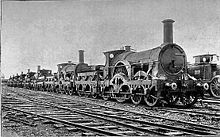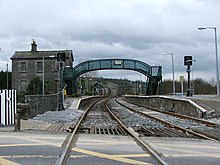Broad-gauge railway
There are replicas of one broad-gauge 2-2-2 locomotive (De Arend) and three carriages in the Nederlands Spoorwegmuseum (Dutch Railway Museum) in Utrecht.In the 1870s (mainly between 1872 and 1874), Canadian broad-gauge lines were changed to standard gauge to facilitate interchange and the exchange of rolling stock with American railroads.In the early days of rail transport in the US, railways tended to be built out from coastal cities into the hinterland, and systems did not initially connect.[7] In 1848, Ohio passed a law stating "The width of the track or gauge of all roads under this act, shall be four feet ten inches between the rails."[8] When American railroads' track extended to the point that they began to interconnect, it became clear that a single nationwide gauge was desirable.The builders and promoters decided that a six-foot track gauge would be needed for locomotives to be larger and more powerful than were in general use at the time, for pulling very large trains.Also the six-foot gauge provided greater stability, and the New York and Erie would operate passenger cars up to 11 feet (3.4 m) wide.Building westward from the Hudson River, it eventually reached Lake Erie, establishing a mainline longer than 400 miles (640 km) providing a shortcut to the American Midwest region from the New York City vicinity, and helping spawn a regional network of six-foot-gauge railroads almost exclusively within New York State.These included the Walkill Valley, the Albany and Susquehanna (later part of the Delaware and Hudson); the Elmira, Jefferson & Canandaigua (later the Northern Central, becoming part of the Pennsylvania Railroad); the Delaware, Lackawanna and Western mainline (which also had a significant amount of trackage in Pennsylvania); predecessor lines of the New York and Oswego Midland (later the New York, Ontario, and Western); and the Canandaigua and Niagara Falls (later becoming part of the New York Central railroad's Peanut Route along the shoreline of Lake Ontario).[11] Pennsylvania trolley gauge of 5 ft 2+1⁄2 in (1,588 mm),[12] is still used on the streetcars in New Orleans, and the Pittsburgh Light Rail system.In the end, the most powerful engines on standard gauge in North America and Scandinavia far exceeded the power of any early broad-gauge locomotive, but then met limits set by other factors such as the capacity of manual stoking, the axle (and total) locomotive weight that would trigger upgrades to the rails and bridges, the maximum wheelbase and/or boiler length compatible with an individual route's curves.The country is planning to build its portion of the Beijing to Moscow high speed railway in broad gauge.Finland and Russia used a modified Alstom Pendolino on the Allegro service between Saint Petersburg and Helsinki at 220 km/h (140 mph).Indian Railways has plans to introduce a higher speed Vande Bharat sleeper train that is capable of 200 km/h, but the project has encountered delays stemming from bids for rolling-stocks with poor local sourcing.India's current high speed railway project is being built on the standard gauge due to limitations imposed by the Japanese consortium funding the project, however the feasibility reports by both the French and German consultants preferred a broad gauge high speed railway.[19] There has been argument for well over a century about the practicability of third rail operation, and numerous devices have been promoted to overcome the problem, especially at turnouts, including the "Brennan Switch".The main railway networks of Spain were initially constructed to a 1,672 mm (5 ft 5+13⁄16 in) gauge of six Castilian feet.In the 1870s, mainly between 1872 and 1874, Canadian broad-gauge lines were changed to standard gauge to facilitate interchange and the exchange of rolling stock with American railways.In the later part of the 20th century, due to interchangeability and maintenance issue, the railways in each of the countries in the Indian Subcontinent began to convert all metre-gauge and narrow-gauge lines to this gauge.



Track gaugeRapid transitMiniatureScale modelMinimumFifteen inchNarrow600 mmTwo footTwo foot three inch750 mmBosnian gaugeTwo foot six inchSwedish three foot900 mmThree footThree foot six inchFour foot six inchStandardItalian broad gaugeDresden gaugeLeipzig gaugeToronto gauge1520 mmFive footFive foot three inchIberian gaugeFive foot six inchBreitspurbahnBogie exchangeBreak of gaugeDual gaugeConversionVariable gaugeNorth AmericaSouth AmericaEuropeAustraliarailwaystandard-gauge railways1,520 mmCIS statesBaltic statesGeorgiaUkraineMongolia1,524 mmFinland1,600 mmIrelandAustralianVictoriaAdelaideSouth Australiapassenger trainsBrazil1,668 mmPortugal1,676 mmPakistanBangladeshSri LankaArgentinaSan Francisco Bay AreaRailway Regulation (Gauge) Act 1846Great Western Railwaysteam locomotivesstandard gaugeGWR Firefly ClassGWR railcarDidcot Railway CentreGreat BritainDundee and Arbroath RailwayArbroath and Forfar RailwayconvertedIsambard Kingdom BrunelPortland HarbourHolyheadsidings7 ft 1⁄4 inGeorge StephensonUnited Kingdom of Great Britain and IrelandGauge CommissionIrish gauge5 ft 3 inHollandsche IJzeren Spoorweg-MaatschappijNederlandsche Rhijnspoorweg-MaatschappijregaugeDe ArendNederlands SpoorwegmuseumGreat Indian Peninsula RailwayBori BunderIndian gaugerelaidSoviet RepublicsRussian EmpireTorontoToronto Transit CommissionToronto streetcar systemsubwayScarborough RTEglinton Crosstown lineFinch WestProvince of Canadachangedhinterland4 ft 10 inNew York StateNew York and ErieAmerican MidwestNew York CityPennsylvania RailroadPennsylvania trolley gauge5 ft 2+1⁄2 instreetcars in New OrleansPittsburgh Light RailPittsburgh RailwaysWest Penn Railwaystrams in Cincinnati5 ft 2+1⁄4 inPhiladelphiaMedia–Sharon Hill LineSubway–Surface TrolleysMarket–Frankford LineBay Area Rapid Transit5 ft 6 in